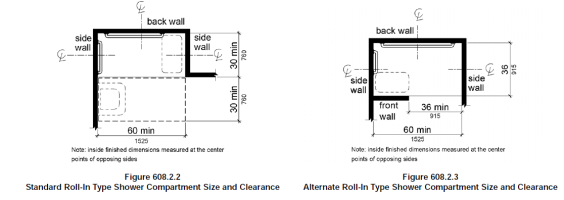What is the "Clearance of 36 (915mm) wide minimum entry on the face of the shower compartment" in the 2010 ADA Standard 608.2.1 trying to describe?
The sentence before this describe a transfer type shower that have absolute dimensions of 36x36. There is no geometric form of a square that has an opening larger than one of it's sides as far as I know on this side of reality.
I can only see this minimum entry definition being able to be applied to the 608.2.3 Alternate Roll-in Type Shower Compartments where there is a front wall and an optional seat that is attached to it for optional transfer. A 36 inch wide minimum entry is also described as a requirement here.
I found a response in the Guide to the ABA Accessibility Standards Common Questions section that answers the question: "Can accessible shower compartments have doors instead of curtains?
The response reads:
Obviously this does not address the issue of closing the door after transfer is made but only the clear opening of some sort of shower enclosure.
I ask this question because others in my office believe that a larger transfer type compartment can be used such as a 36" deep, 42" wide compartment with shower controls on the back wall would work in line with the requirement of the entry being a minimum of 36 inches. I'm not sure that's a correct reading because even if the controls are moved to the back wall that leaves the grab bars too far away from the seat in the compartment which I only found described as a requirement in the U.S. Access Board's accessibility animation Accessible Bathing Facilities video. But then, what's the difference to transferring to an optional seat in a roll-in type shower compartment that's 60 inches wide?
The sentence before this describe a transfer type shower that have absolute dimensions of 36x36. There is no geometric form of a square that has an opening larger than one of it's sides as far as I know on this side of reality.
I can only see this minimum entry definition being able to be applied to the 608.2.3 Alternate Roll-in Type Shower Compartments where there is a front wall and an optional seat that is attached to it for optional transfer. A 36 inch wide minimum entry is also described as a requirement here.
I found a response in the Guide to the ABA Accessibility Standards Common Questions section that answers the question: "Can accessible shower compartments have doors instead of curtains?
The response reads:
Shower enclosures, including doors, cannot obstruct controls, faucets, shower spray units, or transfer from wheelchairs to transfer seats (§608.8). Shower doors on transfer compartments and standard roll-in compartments will typically fail this test. For example, a swing door on a transfer shower will hinder transfer unless it can swing clear of the required clearance, but it will be very hard to close such a door from the shower seat. A door may be possible on an alternate roll-in shower if the shower opening provides a clear width of at least 36” min. when the door is open 90 degrees.
So is it possible that the 608.2.1 of 2010 ADA standard is trying to describe that a 36x36 transfer shower entry needs a minimum 36 inch opening if an enclosure for the compartment is used? (such as a shower door)Obviously this does not address the issue of closing the door after transfer is made but only the clear opening of some sort of shower enclosure.
I ask this question because others in my office believe that a larger transfer type compartment can be used such as a 36" deep, 42" wide compartment with shower controls on the back wall would work in line with the requirement of the entry being a minimum of 36 inches. I'm not sure that's a correct reading because even if the controls are moved to the back wall that leaves the grab bars too far away from the seat in the compartment which I only found described as a requirement in the U.S. Access Board's accessibility animation Accessible Bathing Facilities video. But then, what's the difference to transferring to an optional seat in a roll-in type shower compartment that's 60 inches wide?



